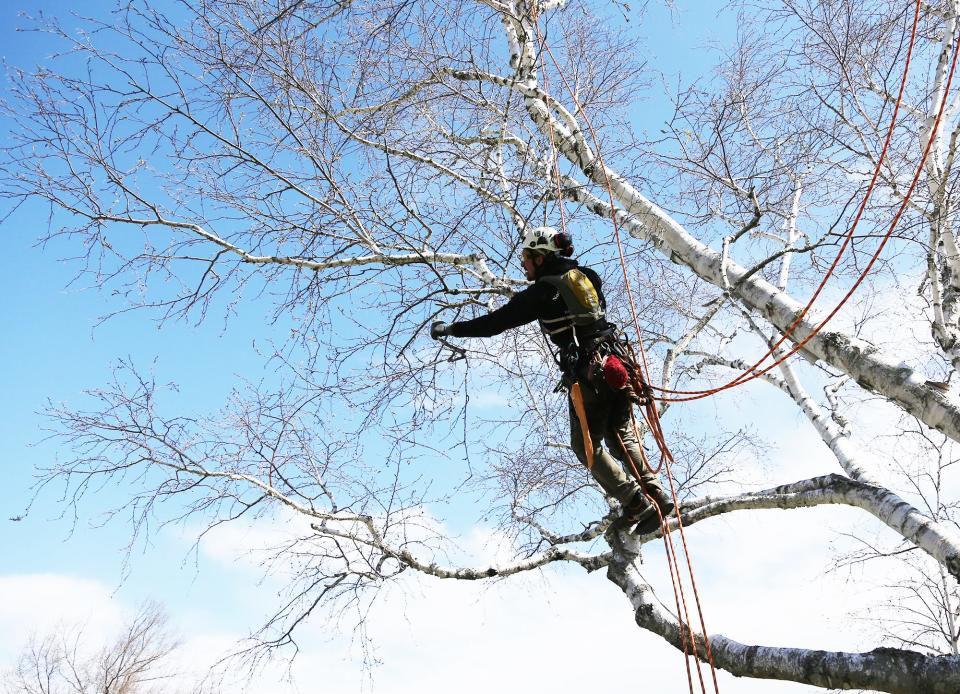NH, utilities warn about dangers of tree trimming near power lines after accidents
CONCORD — The New Hampshire Department of Energy and local utility providers Unitil and Eversource are warning about the dangers of tree trimming and removal work around energized power lines following a series of recent accidents involving tree service contractors hired by homeowners and businesses.
The incidents have not involved tree crews working for the utility companies, but officials are taking steps to raise awareness about proper safety measures in hopes of preventing future accidents. While the recent accidents have mostly involved tree service contractors, taking proper safety precautions and being aware is critical for anyone conducting elevated work at a private home or business — including painters or siding professionals.

“At the New Hampshire Department of Energy, safety is a priority. Although Dig Safe and underground damage prevention get a lot of attention, overhead wires can pose a hazard, too. That’s why we’re working with Eversource and Unitil to ensure the safety of New Hampshire’s utility workers and others who work around electrical equipment,” said Paul G. Kasper, director of the Division of Enforcement at the state Department of Energy.
Kasper urges tree service companies and others contracted to work near power lines to reach out to their local electric company before beginning work; request power line safety covers; and to cover electrical lines and protect themselves from hazardous situations.“It’s quick, free, and the best way to keep your jobsite safe. Let’s protect what matters and make power lines safe,” he said.
The utility companies advise customers and private tree contractors to avoid working near electric lines and to stay at least 10 feet away.
“Safety for our employees and contractors is our top priority as we work every day to provide our customers with reliable electric service,” said Doug Foley Eversource New Hampshire's president of electric operations. “That’s also true for private parties like homeowners and businesses when they’re conducting their own work near our system, and we encourage anyone doing this work to know where power lines are at all times, assume they are energized and keep their distance while being aware of the safety risks.”
Unitil spokesperson Alec O’Meara stressed the importance of ensuring the safety of workers, customers and the general public.
“It’s important to remember that trees can conduct electricity. If any part of a wire is touching a tree, people should avoid touching, climbing, or placing a ladder on the tree to do tree work,” O’Meara said. “Customers should be proactive when hiring a tree company or engaging work on their own and contact Unitil for support.”
Depending on the condition and the location of the tree, the utilities may disconnect the service wire (free of charge) to make the area safe for private tree work; cut a portion of the tree near larger power lines that serve multiple people so a private tree contractor can safely do the tree work; or remove the tree outright in instances where there’s an immediate danger to critical lines.
The utilities also emphasize that only qualified professionals should be hired for tree trimming work, adding that customers should inquire about the tree company’s training and ask if workers have been trained in electrical hazard awareness. They should also be wearing the right gear to do the job in a safe and controlled manner.
In addition, they stress that when performing tree work, it’s important to know where the tree or limb will fall and to make sure there are no power lines in the path.
When performing tree work, the utilities use qualified line-clearance tree trimmers that are specially trained to work within proximity to electrical hazards. They also use insulated bucket trucks and insulated tools that are tested annually.
“Due to their training, our crews are allowed to work closer to the electrical lines with insulated equipment. They also follow Minimum Approach Distances (MAD), which are based on the voltage of the lines,” O’Meara added.
Anyone looking to avoid future problems with vegetation should consider planting only low-growing species near power lines, O’Meara said, adding that more tips on proper planting can be found at https://unitil.com/blog/right-tree-right-place-what-plant-and-how.
Eversource also offers educational resources to customers and advances partnerships with arborists, municipalities, students, and the public about planting the right tree in the right place, including its guide with 30 recommended trees under 30 feet tall.
This article originally appeared on Portsmouth Herald: NH, utilities warn about dangers of tree trimming near power lines

